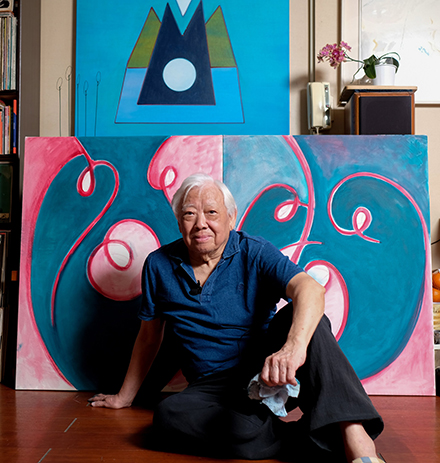
 Born in Nanjing, China, in 1932, Ho Kan is a pioneer of Chinese geometric abstraction and a founding member of the Ton Fan Group, a renowned modern art group in Taiwan. He moved to Taiwan in 1949 to study modern art with Li Chun-Shan. In 1956, Ho, along with seven other painters (Hsia Yang, Hsiao Chin, Li Yuan-chia, Hsiao Ming-hsien, Wu Hao, Tommy Chen, and Ou Yang Wen-yuan), founded Ton Fan to promote the Taiwanese modern art movement, and they have been known as the "Eight Great Outlaws" ever since. In 1964, Ho moved to Milan, Italy, where he lived before returning to settle in Taiwan in 2014.
Born in Nanjing, China, in 1932, Ho Kan is a pioneer of Chinese geometric abstraction and a founding member of the Ton Fan Group, a renowned modern art group in Taiwan. He moved to Taiwan in 1949 to study modern art with Li Chun-Shan. In 1956, Ho, along with seven other painters (Hsia Yang, Hsiao Chin, Li Yuan-chia, Hsiao Ming-hsien, Wu Hao, Tommy Chen, and Ou Yang Wen-yuan), founded Ton Fan to promote the Taiwanese modern art movement, and they have been known as the "Eight Great Outlaws" ever since. In 1964, Ho moved to Milan, Italy, where he lived before returning to settle in Taiwan in 2014.
Ho's early style was mainly surrealist, rendering his early works rather mysterious and spectacular. However, he had already begun exploring geometric shapes in his work during this period. After moving to Milan, he established his individual use of abstract and geometric shapes, focusing on the essence of painting from basic elements: points, lines, planes, and color blocks. With these elements, he studied the overall composition to develop his unique abstract style. Influenced by Western artistic concepts such as hard-edge abstraction, Ho Kan integrates Eastern calligraphy and the art of seal carving with a minimalist yet poetic visual language to develop his distinctive, Eastern lyrical abstraction. He starts with elemental points, and from them, he creates his philosophy about the arrangement of the image, validating the existence of each element. Ho Kan further applies the method of reduction to his abstract art, constructing a more encompassing abstract world that responds to the Eastern philosophical idea that all things are mutually embracing and complementing.
Major exhibitions of Ho's work include a joint exhibition with Lucio Fontana at the Museo Internazionale d'Arte Contemporanea, Italy (1967), a solo exhibition at Comune di Macerata Pinacotecae Musei Comunali Amici dell'Arte, Macerata, Italy (1979), the Ton Fan and Fifth Moon 25th Anniversary Joint Exhibition at the Taiwan Provincial Museum (now the National Taiwan Museum), Taipei, Taiwan (1981), and solo exhibitions of Ho Kan (1994) and Li Chun-Shan and His Pupils (1999), both at the Taiwan Provincial Museum of Fine Arts (now Taiwan Museum of Fine Arts), Taichung, etc. His recent exhibitions include the retrospective "Reverberations.HO KAN" at the Taipei Fine Arts Museum (2016), "Beyond Colors and Shapes: A Retrospective of HO Kan" at the Villa Reale di Monza, Italy (2018), and "Reunion Hong Kong.Nanjing" at Art Basel HK, Exchange Square, Hong Kong, and Jinling Art Museum, Nanjing (2024). Ho has exhibited in many countries, including Italy, Switzerland, the US, the Netherlands, Germany, Japan, China, and many more. His works are included in the collections of the Galleria Nazionale d'Arte Moderna e Contemporanea, Rome, Italy; Museo Internazionale d'Arte Contemporanea, Florence, Italy; BAMPFA, US; Taipei Fine Arts Museum; and the National Taiwan Museum of Fine Arts, Taiwan.